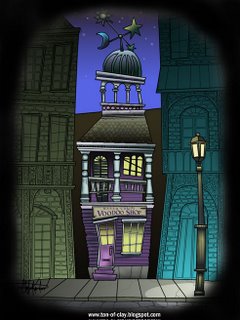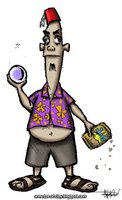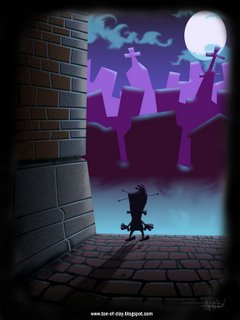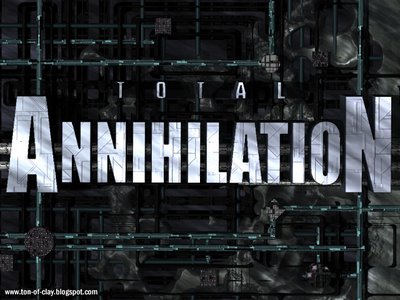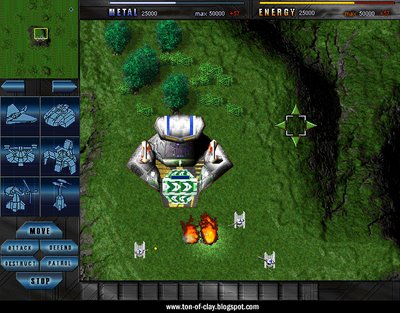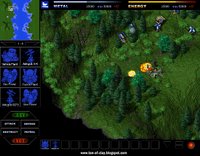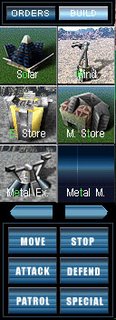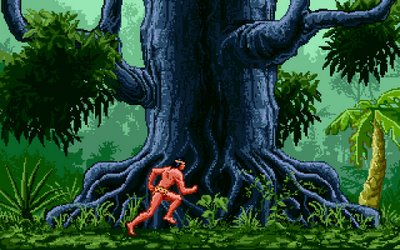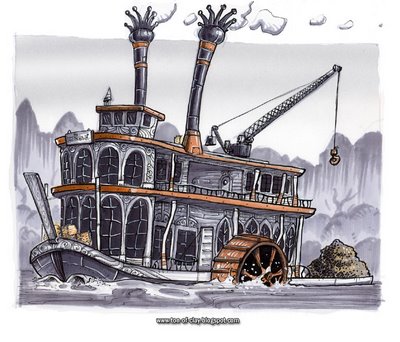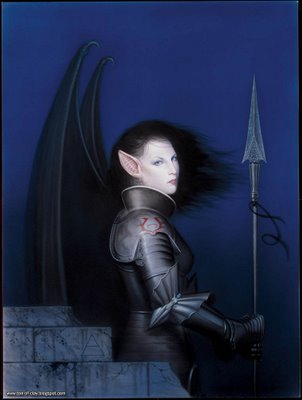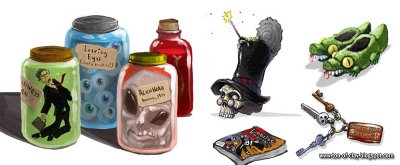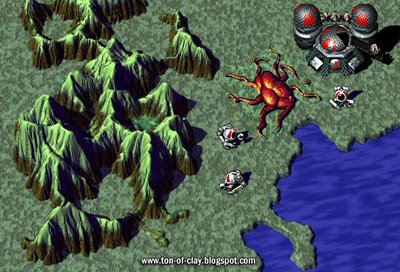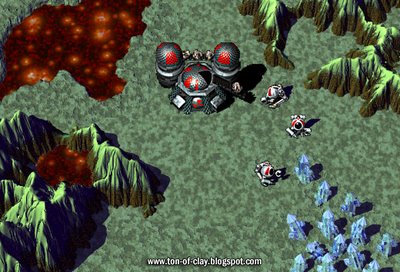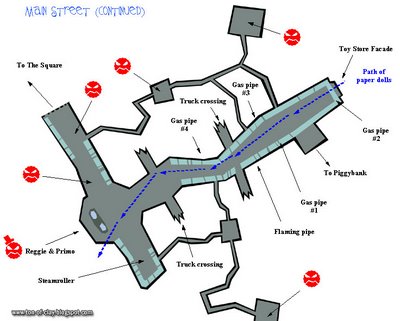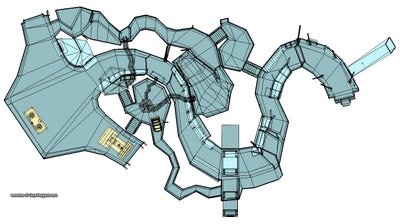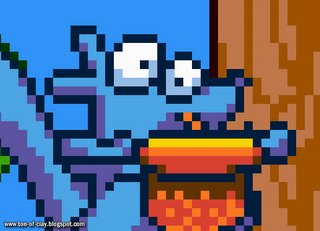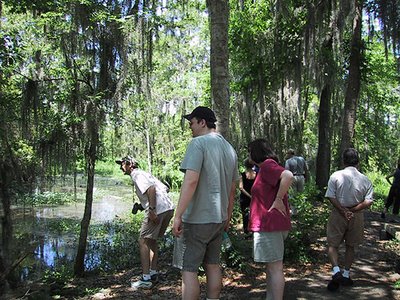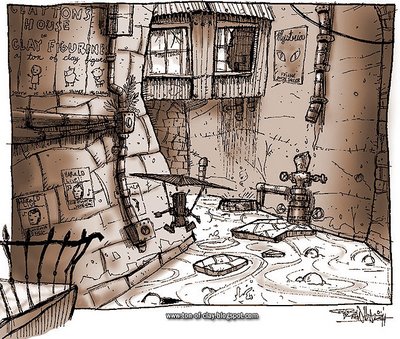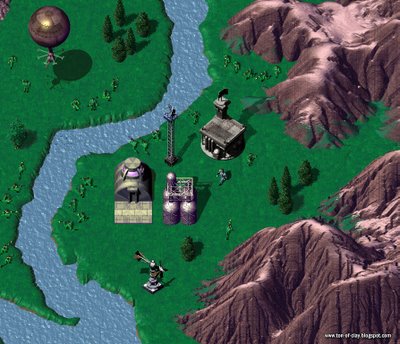 What the hell?!? Did Duke Nukem and Vanilla Ice have a love child?
What the hell?!? Did Duke Nukem and Vanilla Ice have a love child?
Total Annihilation was well received for it's gameplay and design innovations, but there was some criticism for its lack of a deep, engaging story. The heavy hitters in the RTS genre all had swell movies, choc full of the best cut scenes 3D animators and B-list actors could provide.
We started the project firmly convinced we could somehow pull together long, ambitious, jaw-dropping cinematics. During the first couple months, Chris Taylor and I laughed ourselves silly with random ideas for a premise. If we ended up snorting teriyaki and Diet Coke out our noses, we'd put it in the story.
We were leaning toward an extremely, violent, comedic style that would be familiar to fans of the
Venture Brothers today. We knew we had a central figure in the Commander. We had a limited budget, so we figured he would be the only real character in the intro movie. The idea was that the Commanders were identical clones who were at war over the shape of the
glassware in which they were spawned.
Yes, I'm serious.
One had a regular test tube as part of his insignia. The other had an
Erlenmeyer flask. I went home one weekend and whipped up a storyboard for a long, drawn out space battle between two gigantic starships, ending with both Commanders crashing on a desolate alien world. There, they would duke it out to the death. Hot n' spicy... Total A style.
Here are some excerpts from the insanely long storyboard...

Don't worry. We came to our senses. It soon dawned on us that we could have no such thing in the game. We thought the ideas were a hoot, but they would have cost more than the game's whole budget to make. Keep in mind that Total Annihilation was made for a very modest 1.2 million bucks. Game developers spend more than that on
Red Vines and spa treatments these days. We scaled back to simple mission briefings with static graphics and settled for a short intro sequence, and a couple of short movies for the end of each mission series.
A while later, we came up with the names of the sides. Chris and I batted names back and forth like "The Syndicate," and "The Corporation" for our villains. Chris shortened that to simply "the Core." Unit artist Clayton Corbisier came up with "the Arm" for our so-called good guys. He just liked the sound. We did too. Chris then asked me to go home and come up with a simple backstory one evening. He said, "Just some good guys, some bad guys and some reason they're fighting. That's it."
I came back the next day with a document outlining the war between the Arm and the Core, along with some history and possible story arcs for the game. Here is an excerpt:
"Once, the galaxy was united and whole — ruled with scientific precision by the Core. Their citizens lacked nothing. At the zenith of their civilization, the ultimate dream was realized: immortality."Those receiving this awesome gift were selected by Core Central. Their minds were carefully recorded as an advanced digital simulation. Weak and fallible human flesh was cast aside and a perfect, artificial body of dreadful abilities housed the remaining consciousness. This guaranteed that the best and brightest minds could be of use to society indefinitely."This practice made certain factions uneasy — most notably the best and brightest minds in the galaxy. Not every promising leader looked forward to this “immortality”. Gradually, this faction united and chose to live where the influence of the Core was weakest: in a remote spiral arm of the galaxy. As their numbers grew they became known simply as the Arm."This war of ideas became a war in fact. Uneasy with an increasingly vocal opposition, the Core decided to squelch this provincial backwater.
"At first, the Core had a clear advantage. Most of the population and resources of the galaxy were still theirs. But the Arm had a certain resourcefulness that stopped the Core’s best attempts to eradicate them. The Arm learned something new with each encounter, eventually building a war complex to rival that of the Core. What started as a minor skirmish soon blossomed into a vast conflict which would last for thousands of years."
This was later spruced up by veteran game writer, Dave Grossman for the now-familiar (and much catchier) intro sequence to Total Annihilation:
"What began as a conflict over the transfer of consciousness from flesh to machines escalated into a war which has decimated a million worlds. The Core and the Arm have all but exhausted the resources of a galaxy in their struggle for domination. Both sides, now crippled beyond repair. The remnants of their armies continue to battle on ravaged planets; their hatred fueled by over four thousand years of total war. This is a fight to the death. For each side the only acceptable outcome is the complete elimination of the other."

Ah... That's better. Above is my rough storyboard that served as the framework for the intro cinematic to Total Annihilation. Proper units and many more shots were dropped in later, though the Arm Commander didn't change that much.
It's pretty basic stuff, but there are some influences I can cite. I had been reading books with vivid portrayals of what might become of humanity if digitized simluation of human consciousness were a reality. The first was
Feersum Endjinn by Iain Banks. The second was
Permutation City by Greg Egan. Banks deals with a fantastic distant future where the dead live on in a digitized afterlife using a vast computer built into the crust of a planet. Egan portrays early attempts at digitizing a human mind using a more contemporary setting. Both are great reads, by the way, and influenced my thinking when I went home to cook up that skinny premise for TA.
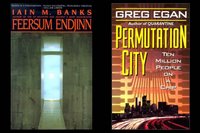
The inclusion of nanotech was for pure convenience. This was about the time we were trying to figure out how to portray construction in the game. It would have been too complex and time consuming to have little guys with hammers and scaffolds every time something was built in the game. It also wasn't futuristic enough. We needed something like magic, but with a thin veneer of science around it. Nanotechnology to the rescue! Two other books influenced my thinking here -
Queen of Angels by Greg Bear and
Diamond Age by Neal Stephenson. The former has a great segment describing the formation of a building inside what amounted to a gigantic glass jello mold. I thought something like that might fit our super cool futuristic war pretty well.
Diamond Age vividly portrays nanotech used in both fabrication and warfare. I proposed the "nanolathe" as the basis for our construction technology. One of the programmers came up with a particle effect (sort of like futuristic space pee) and we were set.
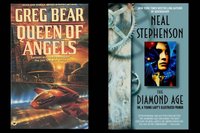
For all that, it's still not much of a story. We were about to enter the Great Real Time Strategy Bloodbath of 1997 and we had a plot you could sum up in one paragraph. Were we crazy?!?
Yes and no.
The lack of story might have turned off a wider audience, but it left plenty of room for all sorts of great expansion and extrapolation. There was room for players to project their own imagination into the story. After I handed off that doc, I didn't write another word about the TA universe. That was okay. Everybody else ran with it. The mission designers added a ton of ideas and all sorts of interesting plot twists.
Fan fiction has taken the saga of the Arm and the Core to a whole new level. The Core is no longer a two dimensional villain, and the Arm isn't just a bunch of pouting malcontents. A real, vibrant universe now hangs on the bones of Total Annihilation's spartan backstory.
I wouldn't have it any other way. Not for all the test tubes in the world.
CK
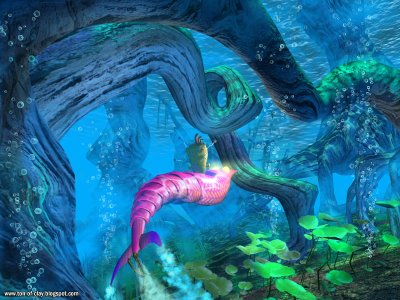 Copyright 2001 Microsoft Corporation
Copyright 2001 Microsoft Corporation
